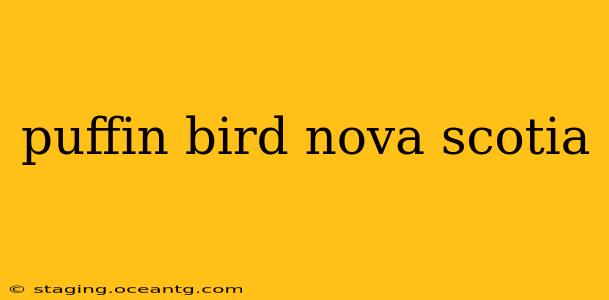Nova Scotia, with its rugged coastline and abundant marine life, offers a fantastic opportunity to witness the charismatic Atlantic Puffin. These charming seabirds, with their brightly colored beaks and comical waddle, are a highlight for many birdwatchers and nature enthusiasts. This comprehensive guide will delve into everything you need to know about spotting puffins in Nova Scotia, ensuring your trip is a successful one.
Where to See Puffins in Nova Scotia?
The best locations to spot puffins in Nova Scotia are generally along the outer coast, where they have access to the rich fishing grounds they depend on. Some of the most popular puffin viewing spots include:
-
Machias Seal Island: Located just off the coast of southwestern Nova Scotia, Machias Seal Island is a renowned puffin colony. Boat tours are essential to access this island, offering incredible close-up views.
-
Bon Portage Island: Situated near Digby, this island is another excellent location for puffin viewing. Tours often combine puffin sightings with other wildlife viewing opportunities.
-
St. Paul Island: Part of the Magdalen Islands, although technically not in Nova Scotia, St. Paul Island is easily accessible from Nova Scotia and boasts a significant puffin population. Boat tours from the Magdalen Islands are readily available.
-
Various other offshore islands: Several other smaller islands along Nova Scotia's coast also support puffin colonies, though access might be more challenging or require specialized tours.
What is the Best Time to See Puffins in Nova Scotia?
Puffins are migratory birds, and the best time to spot them in Nova Scotia is during their breeding season, which typically runs from May to August. During this period, they return to their nesting colonies on the islands and are more readily visible. However, keep in mind that the exact timing can vary slightly depending on weather conditions and other environmental factors.
What Other Wildlife Can I See While Puffin Watching?
Nova Scotia's coastal waters teem with life. While puffin watching, you're likely to encounter other fascinating wildlife, including:
- Various seabirds: Gannets, razorbills, guillemots, and kittiwakes are common companions to puffins.
- Marine mammals: Seals, whales (depending on the season and location), and dolphins might grace your puffin-watching tour.
Are Puffin Tours Necessary?
While you might get lucky spotting puffins from the shore in some locations, organized puffin-watching boat tours are generally recommended. These tours provide safe and efficient access to puffin colonies located on offshore islands, offering the best chances of seeing these elusive birds. Furthermore, knowledgeable guides can point out other wildlife and share fascinating insights into the puffins' behavior and ecology.
What Should I Bring on a Puffin Watching Trip?
To maximize your puffin-watching experience, remember to bring:
- Binoculars: Essential for getting a closer look at these fascinating birds.
- Camera: Capture those incredible photo opportunities! A telephoto lens is highly recommended.
- Warm layers: Even on a sunny day, offshore winds can be chilly.
- Seasickness medication (if needed): Boat trips can be susceptible to rough seas.
- Sunscreen and hat: Protect yourself from the sun's rays.
How Can I Help Protect Puffins?
Atlantic Puffins face various threats, including habitat loss and climate change. By supporting responsible tourism practices, such as choosing reputable tour operators committed to conservation, you can contribute to their protection. Learning about puffin conservation efforts and supporting organizations dedicated to their preservation is another significant way to help.
This guide provides a solid foundation for planning your puffin-watching adventure in Nova Scotia. Remember to check with local tour operators for the most up-to-date information on tour availability and booking. Enjoy your trip, and may your journey be filled with the delightful sight of these incredible seabirds!
